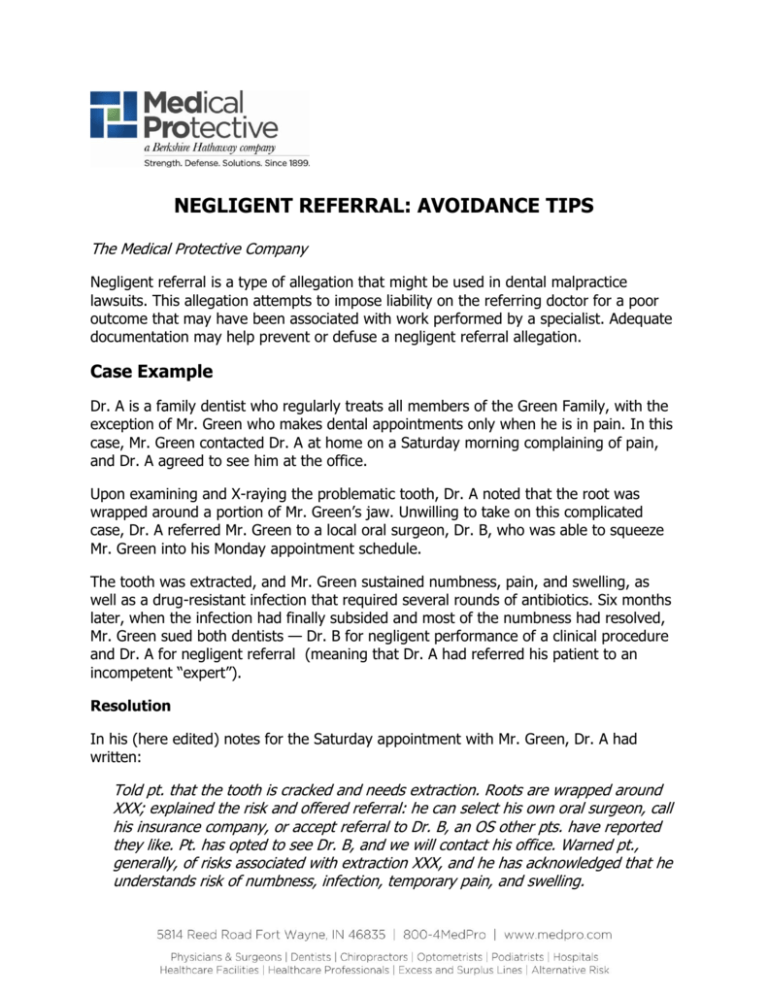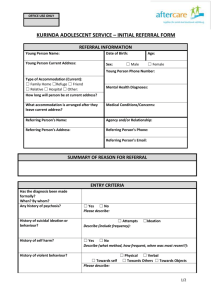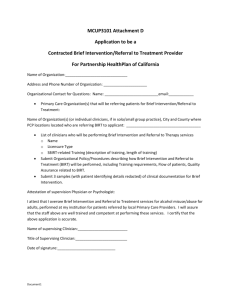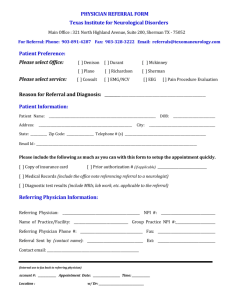
NEGLIGENT REFERRAL: AVOIDANCE TIPS
The Medical Protective Company
Negligent referral is a type of allegation that might be used in dental malpractice
lawsuits. This allegation attempts to impose liability on the referring doctor for a poor
outcome that may have been associated with work performed by a specialist. Adequate
documentation may help prevent or defuse a negligent referral allegation.
Case Example
Dr. A is a family dentist who regularly treats all members of the Green Family, with the
exception of Mr. Green who makes dental appointments only when he is in pain. In this
case, Mr. Green contacted Dr. A at home on a Saturday morning complaining of pain,
and Dr. A agreed to see him at the office.
Upon examining and X-raying the problematic tooth, Dr. A noted that the root was
wrapped around a portion of Mr. Green’s jaw. Unwilling to take on this complicated
case, Dr. A referred Mr. Green to a local oral surgeon, Dr. B, who was able to squeeze
Mr. Green into his Monday appointment schedule.
The tooth was extracted, and Mr. Green sustained numbness, pain, and swelling, as
well as a drug-resistant infection that required several rounds of antibiotics. Six months
later, when the infection had finally subsided and most of the numbness had resolved,
Mr. Green sued both dentists — Dr. B for negligent performance of a clinical procedure
and Dr. A for negligent referral (meaning that Dr. A had referred his patient to an
incompetent “expert”).
Resolution
In his (here edited) notes for the Saturday appointment with Mr. Green, Dr. A had
written:
Told pt. that the tooth is cracked and needs extraction. Roots are wrapped around
XXX; explained the risk and offered referral: he can select his own oral surgeon, call
his insurance company, or accept referral to Dr. B, an OS other pts. have reported
they like. Pt. has opted to see Dr. B, and we will contact his office. Warned pt.,
generally, of risks associated with extraction XXX, and he has acknowledged that he
understands risk of numbness, infection, temporary pain, and swelling.
On the basis of this documentation, the judge dismissed the action against Dr. A, noting
that the patient had been given choices and that he had elected to see Dr. B. The judge
also noted that both Dr. A and Dr. B had warned Mr. Green of the risks associated with
the extraction and that Mr. Green had signed an informed consent before the extraction
acknowledging that he understood these risks.
Risk Tips
It’s always a good idea to document that a patient has been given referral choices,
particularly if the doctor has a preference as to which of several local specialists he
refers patients.
As in the case of Dr. A, asking a patient to confer with his or her insurance company —
or with a local referral service — makes it clear that financial gain isn’t the referring
doctor’s primary purpose. At the same time, the referring doctor may want to avoid
making referrals to someone he doesn’t know at all or, worse yet, someone who has
been unsatisfactory in the past.
From a clinical perspective, the referral process really is all about helping the patient
access the services of a competent specialist. From a risk management perspective, this
includes avoidance of a negligent referral. Further, the referring doctor wants to avoid
the possibility of being accused of unfair criticism of a specialist’s work.
So, what types of conversations should referring dentists be prepared to have with
patients? Here are several examples:
I haven’t referred anyone to Dr. W in quite a while. Dentists don’t always have
the same practice policies or treatment recommendations, and that doesn’t make
either one “wrong”; it’s just usually better for our patients when the dentists
agree on a course of treatment.
Many of my patients have told me that they’re very satisfied with Dr. Y, so I’ve
started referring patients to his practice.
I’m lucky because several good specialists practice in this area. I’ve used Drs. X
and Y — and received good feedback from my patients. Do you have any
questions? That might help us decide which doctor you’d prefer — or, please let
me know if you’d rather see someone else.
In the past, Dr. Z and I haven’t always agreed about how aggressively to treat a
particular condition. I tend to be a little more conservative in my approach, but
seeking other opinions might help you decide if you would rather have a more
aggressive treatment plan.
To help you feel more comfortable about this decision, it might be a good idea if
you get a couple of opinions before making up your mind. That way, you’ll have
all of your questions answered before you make a final decision, and you and I
can make sure we’re on the same page.
When possible, the patient should be included as an active participant in the decisionmaking process. This includes asking the patient if he or she has any particular
questions or concerns about seeing a specialist.
Dentists also should be prepared to respond appropriately to a patient who balks at the
idea of a referral; rather, the patient requests that the treating provider performs the
procedure or treatment. Often, such patients are convinced that the cost will be
substantially lower if they can avoid specialists. Generally, they don’t understand the
potential seriousness of their case.
Further, if their current dentists were to treat them, and the outcome was less than
stellar, they might sue for failure to refer. Education and documentation can help
reduce the risks in these interactions.
Conclusion
Every dentist should have a clear policy about referring patients. A few things to think
about might include:
Am I qualified to perform this procedure/treatment?
Is this patient a candidate for the procedures/treatments I provide?
Do I have sufficient information to determine that I can provide a satisfactory
outcome for this individual?
Explaining the rationale for a treatment recommendation so that it emphasizes the
doctor’s desire to help the patient have the best possible results is important. Although
the patient plays a role in the referral process, the dentist ultimately decides whether
the patient should be referred. The patient either accepts this advice or is free to seek a
different opinion from another dentist. Discussion and documentation are the best ways
to avoid allegations that the referral process harmed a patient.
This article was produced by the clinical risk management team at Medical Protective, the nation’s oldest
professional liability insurance company dedicated to the healthcare professions. For additional
information, please contact Laura Cascella at laura.cascella@medpro.com or visit the Medical Protective
website at http://www.medpro.com/.
©
The Medical Protective Company. All rights reserved.




